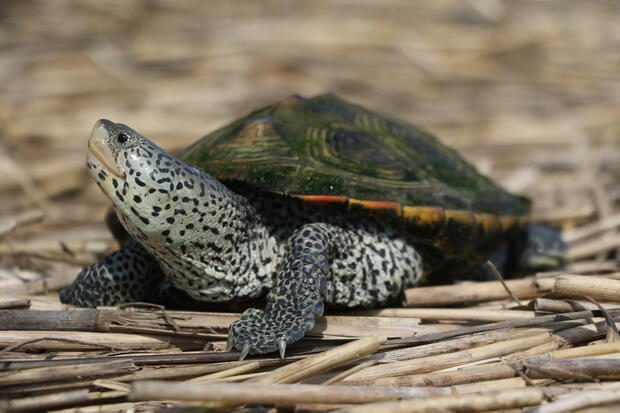Information sharing
Sharing information about habitat condition, road mortality hotspots, opportunities for habitat restoration, illegal or abandoned crab traps that can drown turtles, or terrapin observations can improve our ability to protect terrapins and their habitat.
Report terrapin observations
Turtle observations from the public support conservation initiatives by providing data to MassWildlife biologists. Whether you spot an individual alive or dead, reporting your sighting helps scientist track populations and understand threats. There are 2 ways to report turtle sightings in Massachusetts:
- It's easy to share observations with MassWildlife biologists using the Massachusetts Reptile Survey in iNaturalist. To ensure biologists can access you location information you must join the project and select "trust this project with hidden coordinates".
- Download the iNaturalist app for free, create an account, and start reporting sightings of animals or plants on your phone or at iNaturalist.org. To use iNaturalist, just snap a photo and upload it. You can identify the species or have the app's community help with identification. The exact locations of rare species are automatically obscured to protect sensitive information.
- If you report a reptile observation in Massachusetts, this data will automatically be added to the iNaturalist Massachusetts Reptile Survey (provided you don’t intentionally obscure your location). However, it’s important to join the Massachusetts Reptile Survey and select Yes for “trust this project with hidden coordinates” so biologists at MassWildlife can access the exact location of your observation. The location of rare species observations will still be hidden from the public.
- Reporting observations through MassWildlife’s Heritage Hub is a great option if you already have an account with that application.
Injured terrapins
If you encounter a terrapin with a significant injury, first make sure it is out of immediate danger. If necessary, place the turtle in a box or bucket while you seek help.
Who to call:
- Wareham, Marion, Mattapoisett
- NECWA Hotline: (508) 566-0009
- Anywhere in Buzzards Bay and beyond
- Cape Wildlife Center Hotline: (508) 362-0111
- Curtis Wildlife Center (Weymouth): (781) 682-4878
- Tufts Wildlife Clinic: (508) 839-7918
NOTE: Never leave a turtle inside a closed vehicle where it can easily overheat. Never stop along a road to help injured wildlife unless you able to do so safely. It is illegal to possess terrapins in Massachusetts. The organizations listed above are specially permitted to hold and care for terrapins and other injured wildlife.
Illegal or abandoned crab traps
Recreational blue crabbing is a summer activity enjoyed by many Massachusetts residents and visitors, most commonly with the aid of a handheld dipnet. To prevent the accidental drowning of terrapins, hard-sided crab traps are illegal in Massachusetts and soft-sided collapsible traps must be attended at all times (MA crabbing regulations). Abandoned traps may continue to capture and kill terrapins for many years. Note that lobster traps can be used to capture crabs, but in Massachusetts they are generally illegal to set in the upper estuaries where terrapins are found. Traps can also be used to poach terrapins for illegal pet sales.
If you find a hard-sided trap or an unattended collapsible trap:
- Call Massachusetts Environmental Police (MEP): (800) 632-8075
- If possible, obtain location coordinates and take photos
- Never tamper with an active trap
If you find an abandoned trap:
- If it is absolutely clear that a trap is abandoned (signs may include extreme wear, sedimentation, no bait, no buoy), consider removing or disabling it.
- If in doubt or if you need help, contact the local harbormaster, natural resource officer, NECWA, or MassWildlife.
Other terrapin conservation issues
If you have other observations or suggestions about terrapin conservation in Buzzards Bay, we want to hear from you! Email jonathan.regosin@mass.gov and be sure to include “TERRAPINS” in the subject line
Examples:
- Road mortality hotspots
- Nesting areas in need of improved management
- Opportunities to create additional nesting habitat
- Tidal restrictions or other suggestions related to salt marsh restoration to benefit terrapins
- Interest in volunteering to conduct kayak-based terrapin surveys
Contact
Online
Phone
Open M–F, 8 a.m.–4 p.m. (closed noon–12:30 for lunch)
North/Central/Western Massachusetts
Southeastern Massachusetts/Cape & Islands
Fax
Address
| Date published: | April 7, 2025 |
|---|
